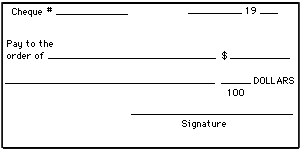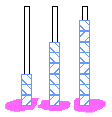Record the following numbers on a audio-cassette.
Be sure to read clearly and slowly repeating each number 3 times.
a)4 987
b)100 001
c)997
d)1 200
e)102 230 342
f)1 billion
g)798.456
h)one thousand and one thousandth
i)5 tenths
j)10 million 3 thousand six
k)one third
l)five tenths
m)32 hundredths
n)11 thousand one hundred twenty one
Add any other number that you wish..
| NOTE: | 1. We do not use "and" as we read larger numbers: "one hundred two" NOT "one hundred and two" |
| 2. NO commas! "2000" and NOT "2,000" | |
| 3. 2000 but we use spaces for more digits - 20 000 |
On the other side of the card, write several numbers that you wish students to read orally on cassette.
Station #2
Make place value cards such as
Place the cards that represent each number in a separate envelope.
On the envelope write the number and the statement:
89 247: The missing card is
On their answer sheets students should write:
"The missing number is eighty nine thousand".
Station #3
Make cards as above using decimal numbers.
Station #4
Make cheque books resembling the following check blank:
Student writing: Invent name of bank, location, account number and add to check.
BILLS: make some or use some that you have that would be appropriate.

Station #5
Great way to integrate the resource centre with mathematics.
Station #6
| Use thin drinking straws for uprights. Cut these straws about 15 cm in length. Use larger drinking straws for the beads. (Straws from McDonalds work well and all you need to do is ask for straws and they are usually very generous. Larger drinking straws are sometimes available at other fast food outlets or at department and at bargain stores.) Cut them into 1-1.5 cm pieces. Insert long thin straw into a small piece of plasticine. Store each set in self sealing plastic bags. |

|
Station #7
For fraction strips have students make their own by paper folding or copy the patterns provided with the activity. Fraction Stax are available from Addison- Wesley Publishers.
Station #8
Adding machine rolls can be purchased in bulk at office supply stores. They go a long way and are good for a variety of projects...
Station #9
To prepare egg cartons: Use several cartons cutting one of each like the following:
singles (twelfths) doubles (sixths) triples (quarters) fours (thirds) sixes (halves) twelves (whole) or twelfths
Differentiate each fraction by painting each one a different color.
You can also place a different color dot with a felt marker.
Station #11
For fraction strips have students make their own by paper folding or copy the patterns provided with the activity. Fraction Stax are available from Addison- Wesley Publishers.
Station #12
Two sided counters can be purchased commercially or made cheaply by placing one layer of white lima beans in a box and spray painting one side. Let dry and you will have buckets of two sided counters.
Station #13
Collect newspaper articles etc. that involve fractions.
Station #14
See previous stations for instructions for egg cartons. For fraction strips have students make their own by paper folding or copy the patterns provided with the activity.
You may wish to cut and paste so that you have many of the same fractions on one page and then you can copy each fraction a different color
Station #15
You can purchase fraction materials commercially or you can use the the patterns provided with the station to make some out of cardboard or plastic covers from duo-tangs (or from foam poster board)
Station #16
Cut paper strips with a paper cutter and store in a box or boxes ready for student use.
Station #17
Again students can make their own fraction strips or you may want to use the ones provided for station 15.
Station #20 & 21
Students will need a fraction calculator recommended in the curriculum guide. These calculators are sold by Addison-Wesley and are also available from the Book Bureau.
Return to Math Central
To return to the previous page use your browser's back button.